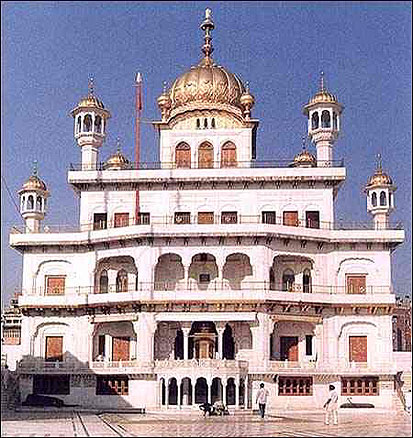|
Sri Akal Takhat
Sahib, Amritsar (Gurudwaras)
Sri Akal Takhat Sahib (lit. the Revered Throne of the Timeless One) Housed in Akal bunga opposite the Darshani Diorhi (gateway to the Harimandir) across the marble paved Parkarma (circumambulatory terrace around the sarovar), is the secular counterpart of purely spiritual or religious Harimandir. It must be kept in mind, though, that in Sikhism, the secular is not divorced from or in opposition to the religious and the spiritual. Sri Akal Takht Sahib is the highest seat of religious authority for the Sikhs. Four other Takhts also have that houour and authority, but Akal Takht is primus inter pares in that hukamnamas (religious fiats) issued by it hold precedence over similar fiats issued by other Takhts. It has been the conventions that only Akal Takht has the authority to try and excommunicate a Sikh for religious offence(s). In any case this is the seniormost in age in that no other Takht came into existence til the birth of Guru Gobind Singh sixty years later. Akal Takht was founded and physically constructed by Guru Hargobind on 15th June 1606. According to Gurbilas Chhevin Patshahi, the Guru laid the foundation and Bhai Buddha and Bhai Gurdas completed the construction, no other person permitted to take part in the process. It was, of course, then only a platform of mud and masonry on which the installation ceremony of Guru Hargobind was performed on 24th June 1606. Guru Hargobind had decided to adopt a princely style. Even his father had approved of and arranged his training in martial sports. And the Gurus, at least from the time of Guru Ram Das, had been given the epithet Sachcha Patshah (the true Sovereign) by their devotees. So there must be a throne for a Patshah. Guru Hargobind was anointed the next Sachcha Patshah on this throne which he named Akal Takht, meaning both the throne of the Timeless or the Timeless Throne. A building over the Akal Takht must have been raised during the time of Guru Hargobind himself. During the period of persecution following the martydom of Banda Singh Bahadur, the Sikhs looked to Sri Akal Takht Sahib, Sri Harimandir Sahib and the Amritsar pool of nectar for frest inspiratino and revived courage. Occasionally, usually on Baisakhi and Divali, different jathas (later misls) assembled at the Akal Takht and held Sarbat Khalsa (assembly representing the entire nation) and passed Gurmatas (resolution is presence of Guru Granth Sahit) related to general strategy, particular operations or other organisational or administrative matters. After the Misls had set up their different independent states, the significance of Sarbat Khalsa assemblies declined, but the supremacy of the Akal Takht as the final arbiter in matters of religious and moral discipline continued to be acknowledged. Like sri Harimandir Sahib, Sri Akal Takht Sahib also suffered destruction at the hands of Ahmad Shah Abdali during his invasion in 1764, because a small garrison of 30 Nihangs stationed here had the audacity to stand up to the invading horde. But what was destroyed was the Akal Bunga, the building, and not Akal Takht, the institution. The Dal Khalsa continued to meet at the Akal Takht on the ruins of Akal Bunga of which, too, the ground floor was reconstructed by 1774. Another four storeys were raised above it diring the reign of Maharaja Ranjit Singh. This was the building which was destroyed with the Indian Army attacked the Darbar Sahib complex early in June 1984. Alarmed at the strong reaction and indignation of the Sikhs, the government hastily reconstructed it, but simultaneously it commited another faux paus - the holding of a fake sarbat Khalsa at the site. This infuriated the Sikhs more than the destruction perpetrated earlier on the building, because this latter act meant an insulting assault on the Akal Takht as an institution. The Sikhs, therefore, ehld a real Sarbat Khalsa in which they, through a Gurmata, decided to pull down the building raised by the government and to reconstruct the Akal Bunga through Kar-Seva (voluntary free service). |
